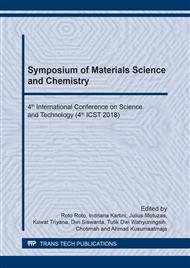[1]
WHO, Media Centre Diabetes, Diabetes, p.11–14, (2013).
Google Scholar
[2]
B. Zhou et al., Worldwide trends in diabetes since 1980: A pooled analysis of 751 population-based studies with 4.4 million participants, Lancet, vol. 387, no. 10027, p.1513–1530, (2016).
Google Scholar
[3]
C. D. Mathers and D. Loncar, Projections of global mortality and burden of disease from 2002 to 2030, PLoS Med., vol. 3, no. 11, p.2011–2030, (2006).
DOI: 10.1371/journal.pmed.0030442
Google Scholar
[4]
B. H. Ginsberg, Blood glucose monitoring: necessary and sufficient?, J. Diabetes Sci. Technol., vol. 1, no. 5, p.612, (2007).
Google Scholar
[5]
L. Zhang and E. Wang, Metal nanoclusters: New fluorescent probes for sensors and bioimaging, Nano Today, vol. 9, no. 1, p.132–157, (2014).
DOI: 10.1016/j.nantod.2014.02.010
Google Scholar
[6]
L. Shang, S. Dong, and G. U. Nienhaus, Ultra-small fluorescent metal nanoclusters: Synthesis and biological applications, Nano Today, vol. 6, no. 4, p.401–418, (2011).
DOI: 10.1016/j.nantod.2011.06.004
Google Scholar
[7]
L. L. Wang, J. Qiao, L. Qi, X. Z. Xu, and D. Li, Construction of OVA-stabilized fluorescent gold nanoclusters for sensing glucose, Sci. China Chem., vol. 58, no. 9, p.1508–1514, (2015).
DOI: 10.1007/s11426-015-5354-5
Google Scholar
[8]
J. Zhang et al., Fluorescent gold nanoclusters based photoelectrochemical sensors for detection of H2O2and glucose, Biosens. Bioelectron., vol. 67, p.296–302, (2015).
Google Scholar
[9]
V. Scognamiglio et al., D-galactose/D-glucose-binding Protein from Escherichia coli as Probe for a Non-consuming Glucose Implantable Fluorescence Biosensor, Sensors, vol. 7, no. 10, p.2484–2491, (2007).
DOI: 10.3390/s7102484
Google Scholar
[10]
K. Palani, D. Kumaran, S. K. Burley, and S. Swaminathan, Structure of a periplasmic glucose-binding protein from Thermotoga maritima, Acta Crystallogr. Sect. F Struct. Biol. Cryst. Commun., vol. 68, no. 12, p.1460–1464, (2012).
DOI: 10.1107/s1744309112045241
Google Scholar
[11]
F. Khan, L. Gnudi, and J. C. Pickup, Fluorescence-based sensing of glucose using engineered glucose/galactose-binding protein: A comparison of fluorescence resonance energy transfer and environmentally sensitive dye labelling strategies, Biochem. Biophys. Res. Commun., vol. 365, no. 1, p.102–106, (2008).
DOI: 10.1016/j.bbrc.2007.10.129
Google Scholar
[12]
B. A. Russell, K. Kubiak-Ossowska, P. A. Mulheran, D. J. S. Birch, and Y. Chen, Locating the nucleation sites for protein encapsulated gold nanoclusters: a molecular dynamics and fluorescence study, Phys. Chem. Chem. Phys., vol. 17, no. 34, p.21935–21941, (2015).
DOI: 10.1039/c5cp02380g
Google Scholar
[13]
N. K. Vyas, M. N. Vyas, and F. A. Quiocho, Sugar and signal-transducer binding sites of the Escherichia coli galactose chemoreceptor protein., Science, vol. 242, no. 4883, p.1290–5, (1988).
DOI: 10.1126/science.3057628
Google Scholar
[14]
N. Foloppe and A. D. MacKerell, All-Atom Empirical Force Field for Nucleic Acids: I. Parameter Optimization Based on Small Molecule and Condensed Phase Macromolecular Target Data, J. Comput. Chem., vol. 21, no. 2, p.86–104, (2000).
DOI: 10.1002/(sici)1096-987x(20000130)21:2<86::aid-jcc2>3.0.co;2-g
Google Scholar
[15]
J. C. Phillips et al., Scalable molecular dynamics with NAMD, J. Comput. Chem., vol. 26, no. 16, p.1781–1802, (2005).
Google Scholar
[16]
S. Raut, R. Chib, S. Butler, J. Borejdo, Z. Gryczynski, and I. Gryczynski, Evidence of energy transfer from tryptophan to BSA/HSA protected gold nanoclusters, Methods Appl. Fluoresc., vol. 2, no. 3, (2014).
DOI: 10.1088/2050-6120/2/3/035004
Google Scholar
[17]
U. Essmann, L. Perera, M. L. Berkowitz, T. Darden, H. Lee, and L. G. Pedersen, A smooth particle mesh Ewald method, J. Chem. Phys., vol. 103, no. 19, p.8577–8593, (1995).
DOI: 10.1063/1.470117
Google Scholar
[18]
C. D. Geddes and J. R. Lakowicz, Glucose Sensing. (2006).
Google Scholar
[19]
M. J. Borrok, L.L. Kiessling, and K. T. Forest, Conformational changes of glucose/galactose-binding protein illuminated by open, unliganded, and ultra-high-resolution ligand-bound structures, Protein Sci., vol. 16, no. 6, p.1032–1041, (2007).
DOI: 10.1110/ps.062707807
Google Scholar
[20]
M.-L. Cui et al., Selective determination of cysteine using BSA-stabilized gold nanoclusters with red emission, Analyst, vol. 137, no. 22, p.5346, (2012).
DOI: 10.1039/c2an36284h
Google Scholar
[21]
J. Xie, Y. Zheng, and J. Y. Ying, Protein-Directed Synthesis of Highly Fluorescent Gold Nanoclusters, J. Agric. Food Chem., p.888–889, (2009).
DOI: 10.1021/ja806804u
Google Scholar
[22]
H. KAWASAKI, K. YOSHIMURA, K. HAMAGUCHI, and R. ARAKAWA, Trypsin-Stabilized Fluorescent Gold Nanocluster for Sensitive and Selective Hg2+ Detection, Anal. Sci., vol. 27, no. 6, p.591, (2011).
DOI: 10.2116/analsci.27.591
Google Scholar


